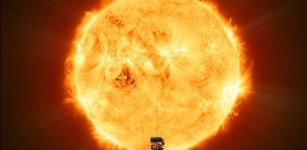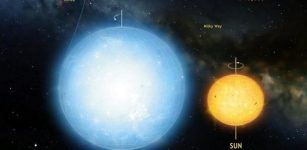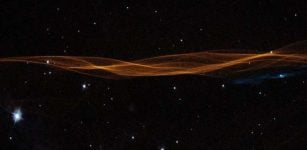Attempt To Explain Enigmatic Gigantic Troughs On Vesta
MessageToEagle.com – Scientists have been trying to determine the origin of gigantic troughs on asteroid Vesta since their discovery just last year.
A new analysis supports the notion that the troughs are faults that formed when a fellow asteroid smacked into Vesta’s South Pole.
The research reinforces the claim that Vesta has a layered interior, a quality normally reserved for larger bodies, such as planets and large moons.
Asteroid surface deformities are typically straightforward cracks formed by crashes with other asteroids.

Instead, an extensive system of troughs encircles Vesta, the second most massive asteroid in the solar system, about one-seventh as wide as the Moon. The biggest of those troughs, named Divalia Fossa, surpasses the size of the Grand Canyon by spanning 465 kilometers (289 miles) long, 22 km (13.6 mi) wide and 5 km (3 mi) deep. The origin of these troughs on Vesta has puzzled scientists. The complexity of their formation can’t be explained by simple collisions.
New measurements of Vesta’s topography, derived from images of Vesta taken by NASA’s Dawn spacecraft last year, indicate that a large collision could have created the asteroid’s troughs.
According to Debra Buczkowski of the Johns Hopkins University Applied Physics Laboratory in Laurel, Md., this would only have been possible if the asteroid is differentiated — meaning that it has a core, mantle and crust.

“Because Vesta is differentiated, its layers have different densities, which react differently to the force from the impact and make it possible for the faulted surface to slide,” Buczkowski added. “By saying it’s differentiated, we’re basically saying Vesta was a little planet trying to happen.” Most asteroids are pretty simple.
“They’re just like giant rocks in space,” said Buczkowski. But previous research has found signs of igneous rock on Vesta, indicating that rock on Vesta’s surface was once molten, a sign of differentiation. If the troughs are made possible by differentiation, then the cracks aren’t just troughs, they’re graben.
A graben is a dip in the surface that forms when two faults move apart from each other and the ground sinks into the widening gap, such as in Death Valley in California. Scientists have also observed graben on the Moon and planets such as Mars. The images from the Dawn mission show that Vesta’s troughs have many of the qualities of graben,” said Buczkowski.
For example, the walls of troughs on simpler asteroids such as Eros and Lutetia are shaped like the letter V. But Vesta’s troughs have floors that are flat or curved and have distinct walls on either side, like the letter U — a signature of a fault moving apart, instead of simple cracking on the surface.

Up and Down in Vesta’s Cratered Terrain
The scientists’ measurements also showed that the bottoms of the troughs on Vesta are relatively flat and slanted toward what’s probably a dominant fault, much as they are in Earth-bound graben.
Additionally, Vesta is unusually planet-like for an asteroid in that its mantle is ductile and can stretch under a lot of pressure. Formed more like a walnut and unlike the larger asteroid Ceres, Vesta is not classified as a dwarf planet.
Regardless of its shape, however, if Vesta has a mantle and core, that would mean it has qualities often reserved for planets, dwarf planets and moons.
Scientists believe that Vesta’s south pole collision knocked Vesta into its current speedy rate of rotation about its axis of about once per 5.35 hours, which may have caused the equator to bulge outward so far and so fast that the rotation caused the troughs, rather than the direct power of the impact, according to Britney Schmidt of the Institute for Geophysics in Austin, Texas.
“It’s an enigma why Vesta rotates so quickly,” she said.
The team’s research will be published online this Saturday in Geophysical Research Letters.
MessageToEagle.com










